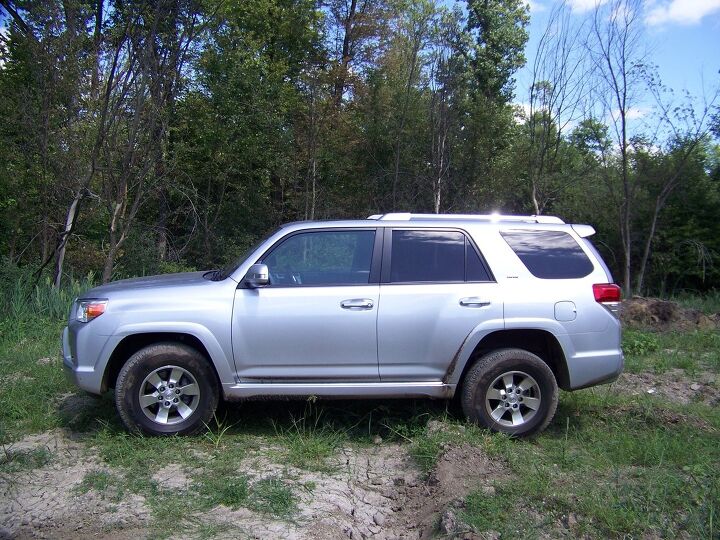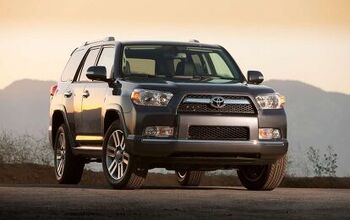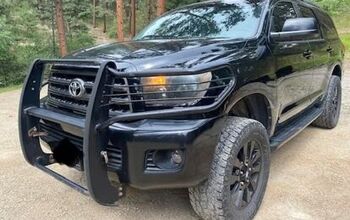Review: 2010 Toyota 4Runner SR5
After ruling the American roads for most of the 1990s and 2000s, the conventional midsize SUV has rapidly become an endangered species. GM, Ford, and others have abandoned the segment entirely. The Grand Cherokee, from its inception intended for more of an on-road role than other Jeeps, has become ever more refined and luxurious in a bid to survive. Nissan still offers the Pathfinder, but will it still be a conventional SUV if and when it’s redesigned? The Borrego? A mistake Kia won’t be making a second time. Only one company has had the guts and/or cluelessness to recently redesign a midsize SUV that is first and foremost an SUV. Could the 2010 Toyota 4Runner be the last of its kind?
While competitors have become more car-like with each iteration, the 4Runner has been moving in the opposite direction. Unlike the 2011 Grand Cherokee, the fifth-generation Toyota wasn’t intended to be pretty from any angle, and isn’t. Instead, dramatically chunky styling, upright pillars, and short overhangs proudly proclaim that it’s no crossover. Valets at fancy restaurants won’t be parking it in the front row, or even the second row.
The mucho macho aesthetic continues inside the 4Runner. Children and even shorter adults struggle to get in and out. You sense every inch of the 4Runner’s height when gazing over the vast expanse of the hood (actually visible) through the distant, upright windshield. You’re most obviously not in a car. Everything from the steering wheel to the shift lever to the door pulls to the secondary controls on the center stack is sized for Real Men. As with the Hummers that were likely an inspiration, heavy use of boombox-quality silver-painted plastic undermines pretensions to ruggedness. Within this environment, comfortably upholstered door panels are an
unexpected surprise. A concession to commuters? Or to cushion elbows while traversing boulder fields? The large seats, though upholstered in leather, aren’t as cushy or luxurious. The first and second rows are roomier than in past 4Runners. A tight third row is available, but wasn’t present on the tested vehicle. Continuing a 4Runner tradition, the rear window can be lowered to let the breeze flow through.
The DOHC 270-horsepower, 278-pound-feet 4.0-liter V6 starts with a loud, old-fashioned roar—the cooling fan seems on by default. No V8 is available this time around, and unless you’re especially hungry for torque it’s not missed. Though down 20-horsepower compared to the 3.6-liter “Phoenix” V6 in the new Grand Cherokee, the Toyota engine feels considerably stronger, if not quick to react to throttle inputs. Curb weights are about the same (4,675 lbs. for the Toyota, 4,660 for the Jeep), but the Toyota mill has a stouter midrange and gets a boost from shorter gearing. The EPA ratings of 17/22 are easily attained. In suburban driving I mostly
observed 16.5 to 18.5, with the occasional stint pushing 20. Not impressed? Remember that this is a heavy, conventional SUV with the aerodynamics of a barn, relatively short gearing, and wide truck tires.
The on-road handling is very much that of a conventional SUV. Live rear axle? Gone from the Jeep Grand Cherokee, Nissan Pathfinder, and Kia Borrego. Still here. The moderately light steering, though decently weighted, is numb and slow. The chassis heavily understeers initially, but thanks to the rear end’s greater propensity to lean transitions to oversteer as cornering forces build, prompting the stability control to aggressively intervene. (The Limited’s X-REAS suspension system, which hydraulically cross-links the shocks, might reduce lean and improve balance; the tested vehicle was an SR5.)
The most-definitely-not-low profile 265/70R17 Dunlop Grandtreks provide
limited grip, though there’s enough to confidently take curves at their posted speed. (The Limited is shod with 245/60R20s, but if you’d prefer those then the 4Runner probably isn’t the right truck for you.) With so much evident mass in play, slides don’t stop quickly once they start. Driven quickly over severely disheveled pavement the 4Runner bounds and heaves, but otherwise rides smoothly, if sometimes with a touch of float. The tires are quiet for SUV treads, but can get a little noisy on concrete. Poor on-road handling by any objective measure, and yet a refreshing change of pace from anodyne crossovers. I struggle to remember what the new Grand Cherokee felt like, because it doesn’t feel like much of anything. There’s no such issue with the 4Runner.
Venture off-road, and suddenly the 4Runner’s throttle, steering, and suspension tuning makes sense. There’s little danger that the engine will provide more thrust than you’re asking for. Ride quality is excellent on dirt
and gravel roads. Washboard surfaces? Not a problem. Manually shift into 4-Lo to traverse some deep ruts, and the steering remains undisturbed—so little gets through it’s uncanny—while the tall sidewalls and soft springs suck up impacts. The body structure feels rock solid throughout (as it should given the curb weight). Retain any doubts about the 4Runner’s intended mission? There’s a switch to disable the rollover sensor for the airbags. One slip: the molding around the rear wheel opening collects mud. Don’t want off-road-friendly tuning when on-road? Too bad. Unless you spend more for the Trail model, there’s no terrain-based mode selector like the one Ford and Jeep have cribbed from Land Rover.
With the latest 4Runner, Toyota made few concessions to the primary market served by SUVs during their boom. Want a midsize four-door SUV that remains every bit an SUV, for doing things that only a real SUV can do? Then this might soon be your only choice. Hate it? My wife certainly did. Then Toyota will gladly sell you a Highlander.
Toyota provided the vehicle, insurance and one tank of gas for this review
Michael Karesh owns and operates TrueDelta, an online source of automotive pricing and reliability data
Michael Karesh lives in West Bloomfield, Michigan, with his wife and three children. In 2003 he received a Ph.D. from the University of Chicago. While in Chicago he worked at the National Opinion Research Center, a leader in the field of survey research. For his doctoral thesis, he spent a year-and-a-half inside an automaker studying how and how well it understood consumers when developing new products. While pursuing the degree he taught consumer behavior and product development at Oakland University. Since 1999, he has contributed auto reviews to Epinions, where he is currently one of two people in charge of the autos section. Since earning the degree he has continued to care for his children (school, gymnastics, tae-kwan-do...) and write reviews for Epinions and, more recently, The Truth About Cars while developing TrueDelta, a vehicle reliability and price comparison site.
More by Michael Karesh
Latest Car Reviews
Read moreLatest Product Reviews
Read moreRecent Comments
- Daniel J Cx-5 lol. It's why we have one. I love hybrids but the engine in the RAV4 is just loud and obnoxious when it fires up.
- Oberkanone CX-5 diesel.
- Oberkanone Autonomous cars are afraid of us.
- Theflyersfan I always thought this gen XC90 could be compared to Mercedes' first-gen M-class. Everyone in every suburban family in every moderate-upper-class neighborhood got one and they were both a dumpster fire of quality. It's looking like Volvo finally worked out the quality issues, but that was a bad launch. And now I shall sound like every car site commenter over the last 25 years and say that Volvo all but killed their excellent line of wagons and replaced them with unreliable, overweight wagons on stilts just so some "I'll be famous on TikTok someday" mom won't be seen in a wagon or minivan dropping the rug rats off at school.
- Theflyersfan For the stop-and-go slog when sitting on something like The 405 or The Capital Beltway, sure. It's slow and there's time to react if something goes wrong. 85 mph in Texas with lane restriping and construction coming up? Not a chance. Radar cruise control is already glitchy enough with uneven distances, lane keeping assist is so hyperactive that it's turned off, and auto-braking's sole purpose is to launch loose objects in the car forward. Put them together and what could go wrong???

















































Comments
Join the conversation
I still see no reason to trade my first generation 4Runner in on something like this which has become excessively bloated. I understand that most of these 'Runners are going to be doing family hauling detail, but come on, a 3rd row seat in an off-roader? My '85 with a solid front axle and its basic modifications will totally destroy this thing off-road, but I will admit that I couldn't keep up with the newest generation out on the highway seeing how a 116 hp 4 cylinder engine pushing 31 inch tires doesn't see much north of 70 mph... but I do get 22 mpg easily. In the future I'd like to see the 4Runner go down in size. Toyota has plenty of offerings in this size of a vehicle designed for family truckster duty, that'll work better with less compromises. Trim a thousand pounds off the curb weight, and while you're at it Toyota, trim off that wimpy IFS that will eventually get torched by anybody who reads pirate4x4.com anyway. If all that happened, you're talking a vehicle that a lot of buyers would be interested in, including myself.
If you see an owner of a 4Runner, you are meeting a person of very high quality If you own a 4Runner, you are one of the few who hasn't "Gone soft" over the last 20 years or so. As they used to say, you have some "crust" to ya! BD